Inflation and interest rates continue to rise

The annual inflation rate in the United States rose from 7.0 percent as of December 31, 2021, to 7.5 percent at the end of January 2022. As icing on the cake, Fed's Bullard did not rule out an increase of one whole percentage point in June. It lowered the mood amongst stock market investors.
In this weekly trading note from Carlsquare, we elaborate on the following topics, indices, and stocks:
- Inflation and interest rates continue to rise
- Lagarde and inflation creating volatility in EUR/USD
- Fast-rising rates are a scary thing for S&P 500
- Is tech-heavy Nasdaq showing signs of leading the way?
- OMXS30 consolidating ahead of a more significant move?
- Will DAX approach the 15 000-level?
- Natural gas, an indicator for the risk of war between Russia and Ukraine
- Will the travel and leisure sector outperform?
- The Q4 2021 reporting season
- Meta share is looking for its bottom
The annual inflation rate in the United States rose from 7.0 percent as of December 31, 2021, to 7.5 percent at the end of January 2022. As icing on the cake, Fed's Bullard did not rule out an increase of one whole percentage point in June. It lowered the mood amongst stock market investors.
It is not surprising that the market is nervous as the inflation rate is not slowing down but rather continuing to rise. Today's interest rates are unreasonably low unless the inflation rate is at least partly transitory. A roughly halving within less than a year from today's highs seems to be in investors' expectations. Otherwise, we will have negative interest rates adjusted for inflation of around 5 percent.
US annual inflation rate from January 31, 2021, to January 31, 2022

Over the past two weeks, the 10-year US Treasury yield has risen from 1.78% to 2.04%.
But even given one or two percentage points increase, today's US interest rates will still be significantly lower than in the year 2000 when the US 10-year Treasury yield was 6.6% or in 2008 when the Treasury yield was 4%. We are seeing a normalization, the economy returning to a growth rate that is slightly better than before the Covid outbreak in March 2020. Bond yields are still too low to attract investors since interest rates do not compensate for the current inflation rate. TINA ("There Is No Alternative"- to stocks) is still a valid argument for investors, but how long?
The US 10-year Treasury yield crossed the magic 1.5% mark around the turn of the year and has continued to rise towards the 2% level without the Fed intervening.
US 2, 10, and 30-year yield and S&P 500, five-year chart

Looking at Friday's and last month's performance of some of the major stock market indices, the S&P 500 and Nasdaq 100 have been the worst performers. With around 60% of the world's total market capitalization, the US markets are leading as interest rates rise. But perhaps also because valuations are generally higher on the US stock exchanges, compared to Europe and Asia. The valuation of growth companies with longer-term profits is most affected by increasing investor return requirements. When comparing the Dow Jones Index relative return to S&P 500 and Nasdaq 100, there is a difference where value has performed better than growth stocks.
Significant stock indices performance on Friday, February 11, 2022, in one week and one month

Lagarde and inflation creating volatility in EUR/USD
ECB's Lagarde was hawkish and then turned a little dovish by saying that increased rates will not dampen the inflation as supply chain issues primarily create it. That one may be difficult to argue against, but Fed does seem to have another view. Lagarde and higher-than-expected inflation in the US has produced some volatility in the EUR/USD. The EUR/USD is back trading by the floor of a slightly rising trend channel. Will it hold?
EUR/USD graph: June 10, 2021, to February 4, 2022

In the weekly chart, MACD has recently generated a weak buy signal:
EUR/USD, weekly five-year price graph

Fast-rising rates are a scary thing for S&P 500
The rapid increase in the rates is scary for the stock market. The selling pressure started already on Thursday, and the bearish mood continued on Friday even though rates came back down. As shown in the chart below, S&P 500 closed last week below Fibonacci 38.2 and MA200. The next level on the downside is likely to be found around 4 350, just below where Fibonacci 23.6 meet up:
S&P 500 price graph: June 17, 2021, to February 11, 2022

The weekly chart shows how the index attempted to retake MA20 and EMA9 but failed. MA50 serves as support on the downside. A declining MACD is worrisome.
S&P 500, weekly five-year price graph
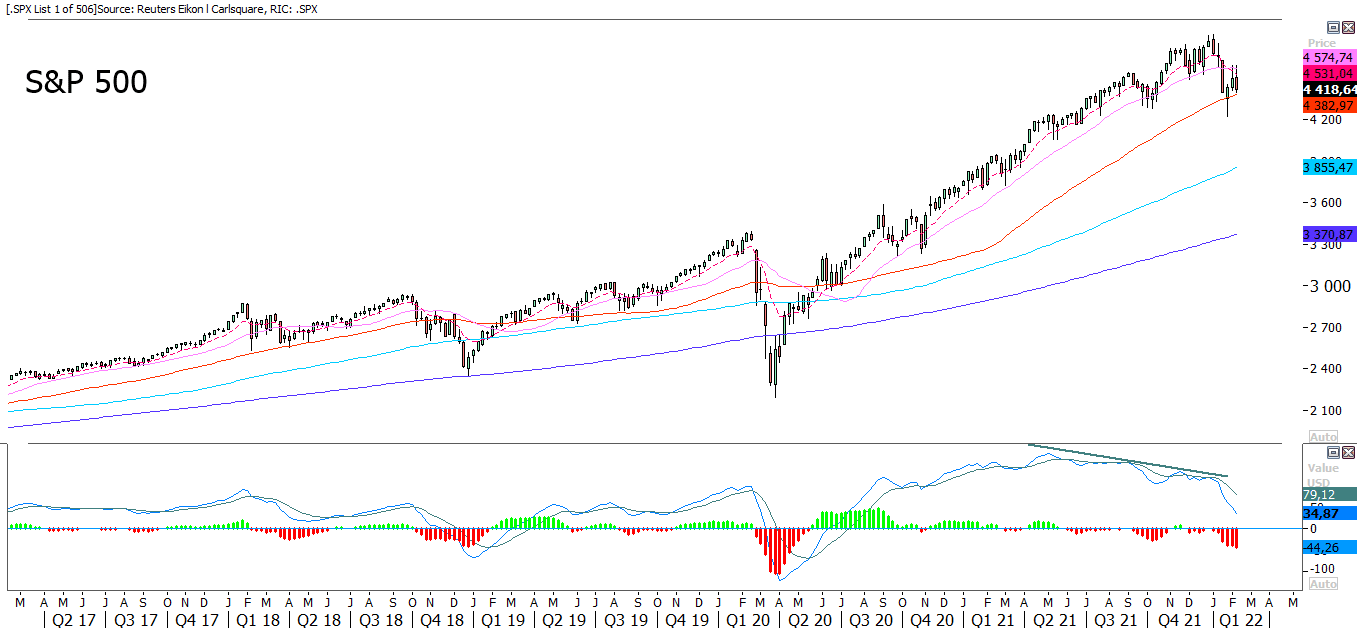
Is tech-heavy Nasdaq showing signs of leading the way?
Tech heavy Nasdaq 100 was slaughtered on Friday, closing down 3.0 percent. As shown in the chart below, the index closed below Fibonacci 23.6. Is the psychologically important level of 14 000 next? Or will the falling rates on Friday encourage investors trying to find nice dips (or falling knives) to buy?
Nasdaq 100 price graph: June 17, 2021, to February 11, 2022

The weekly chart shows Nasdaq failed to retake MA50. Will the negative divergence between MACD and the index have more to give on the downside?
Nasdaq 100, weekly five-year price graph
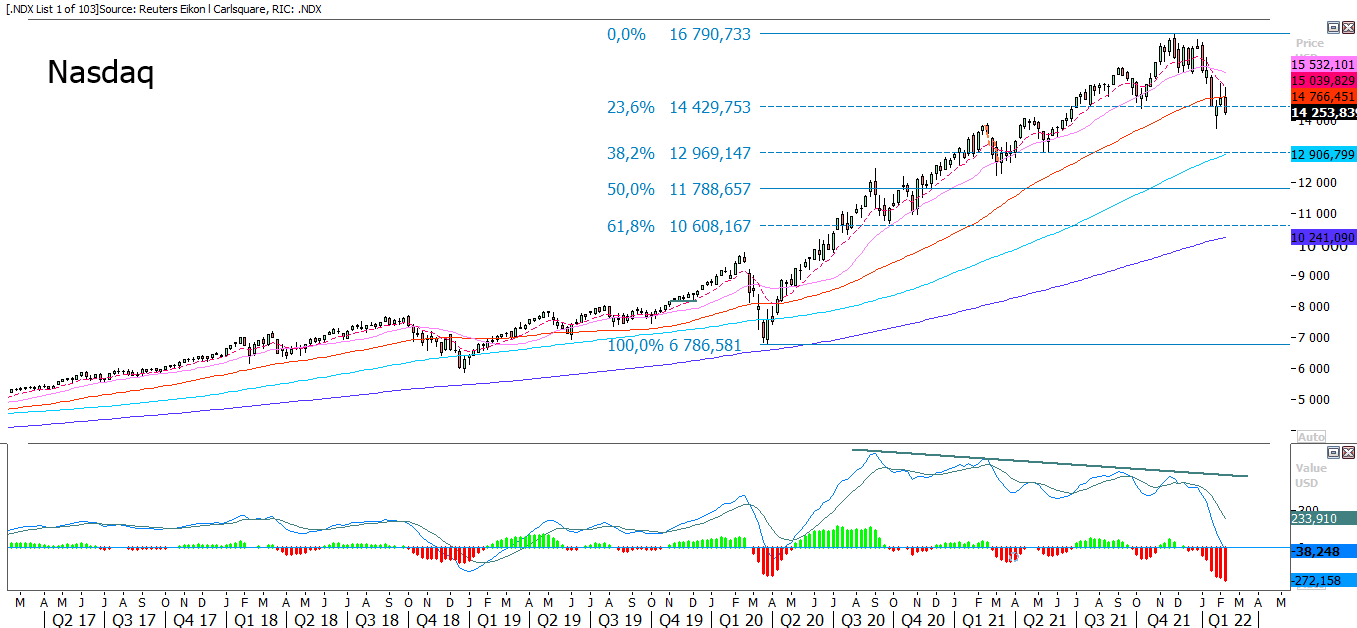
OMXS30 consolidating ahead of a more significant move?
OMXS30 is consolidating in yet another neutral wedge formation. The formation will probably be followed by a move equal to the broadest part of the wedge formation. Will the move be to the upside or downside? Either or, the selling in the US was hard during the last three trading hours, calling for an initial selling pressure in today's trading.
OMXS30 price graph: June 17, 2021, to February 11, 2022
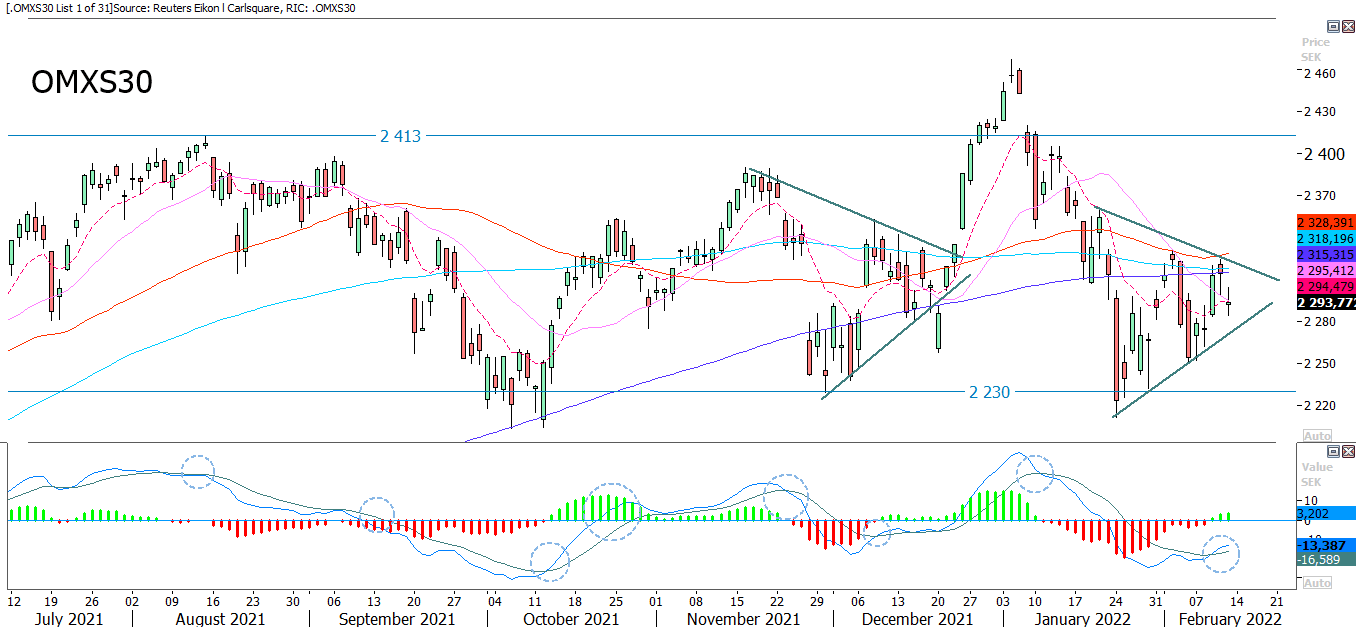
The weekly chart below shows how OMXS30 trades around MA50 under a falling momentum visualized by MACD.
OMXS30, weekly five-year price graph
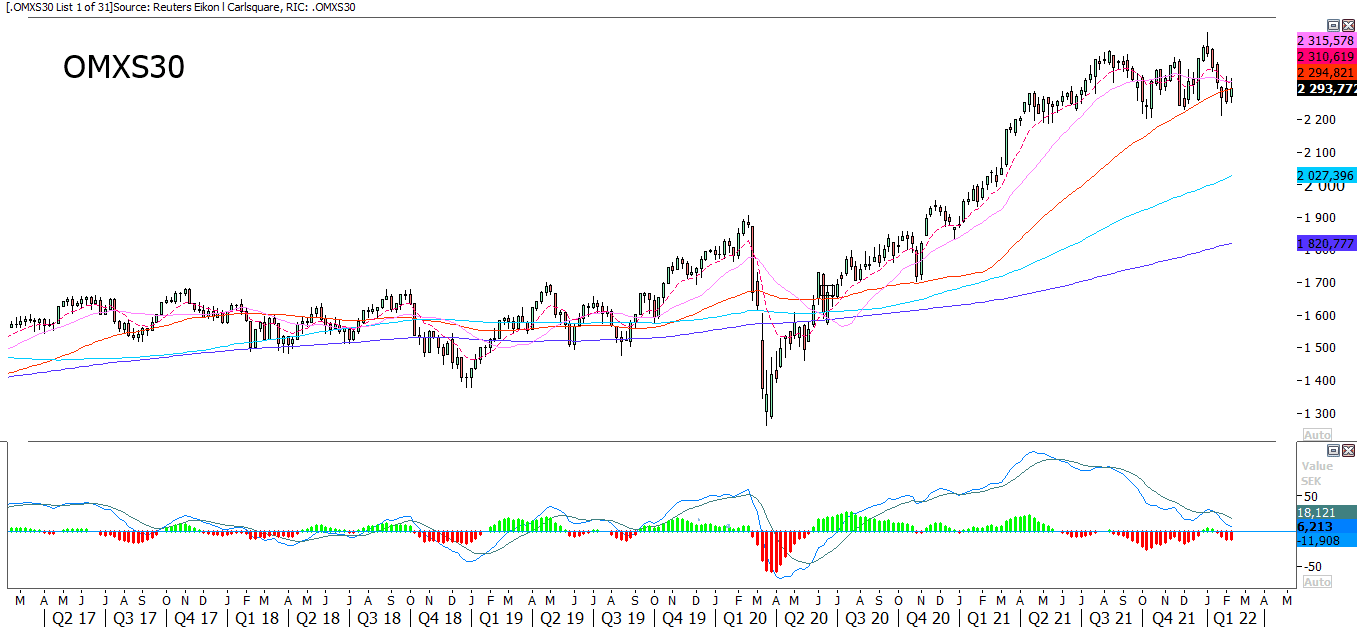
Will DAX approach the 15 000-level?
DAX attempted to test the cluster of resistances on Thursday's opening but failed. On Friday, the index also managed to close below MA20. We expect initial selling pressure. If the sentiment continues, perhaps we will see a test of the 15 000-level soon.
DAX price graph: June 17, 2021, to February 11, 2022
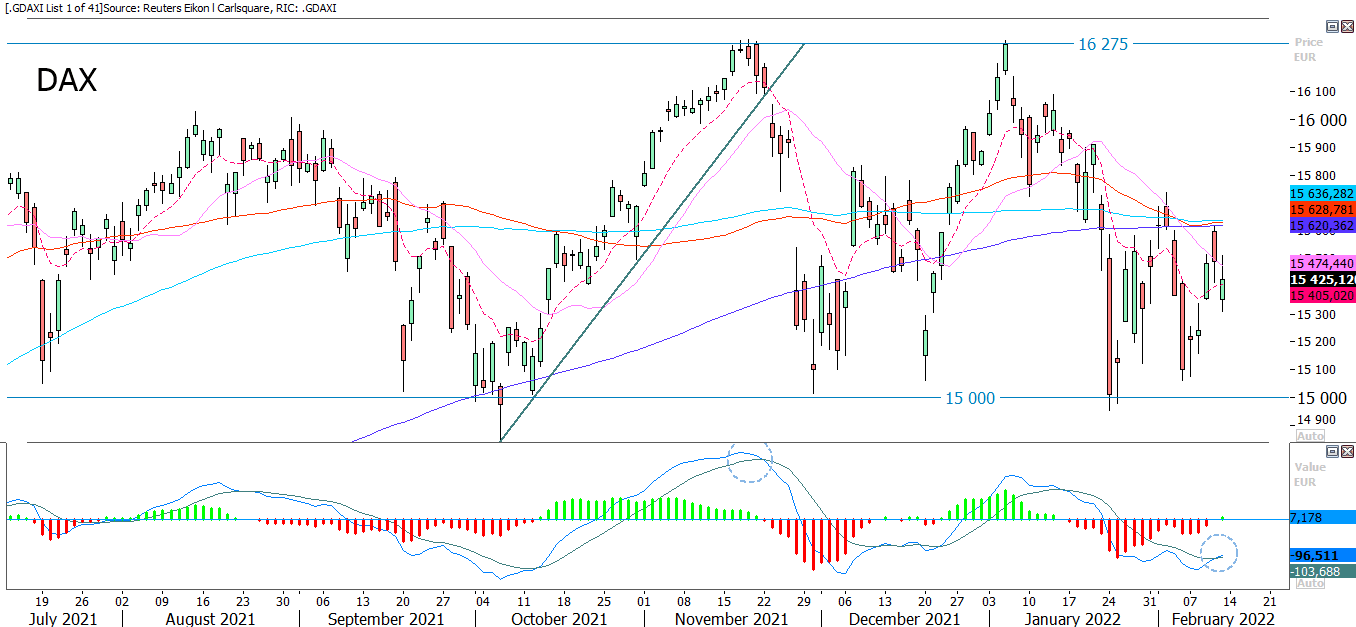
DAX is pushed downwards in the weekly chart by slightly falling EMA9 and MA20. Again, the falling MACD is worrisome.
DAX, weekly five-year price graph
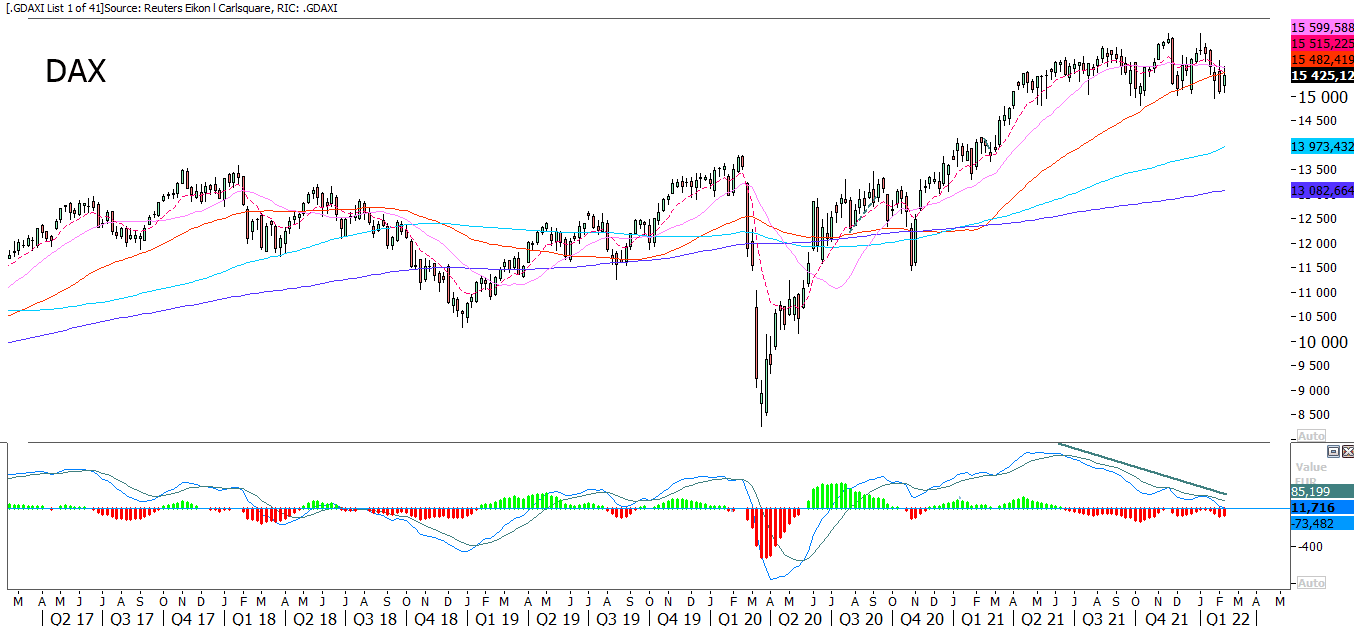
Natural gas, an indicator for the risk of war between Russia and Ukraine
According to US intelligence, the risk of war in the form of a Russian invasion of Ukraine has increased. Sweden and many other Western countries have begun to repatriate their citizens from Ukraine. The authorities also advise their citizens not to enter Ukraine. The increased risk of war, or at least rearmament, is illustrated by the rising share prices of defense and war material companies. But the share price development has gone in waves. It looks more like the price has peaked for this time. Do we witness a buy on rumors, sell on facts-session?
iShares US Aerospace and Defence ETF price graph from June 21, 2021, to February 11, 2022
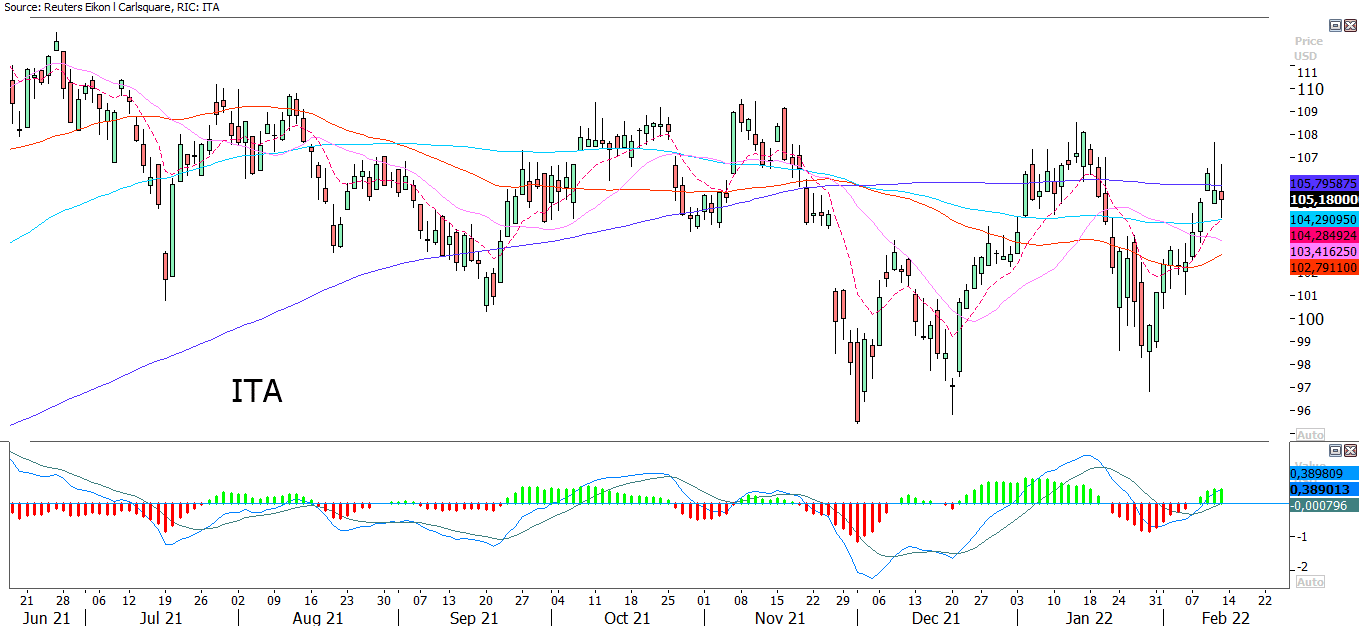
The development of natural gas, given the sizeable Russian supply, may also indicate the markets' perception of the risk of war and disruptions in store as a potential consequence. The chart below shows that natural gas is currently trading below a rising trendline. Note the Doji created on Friday, implying uncertainty of the next move.
Natural gas price graph: June 17, 2021, to February 11, 2022
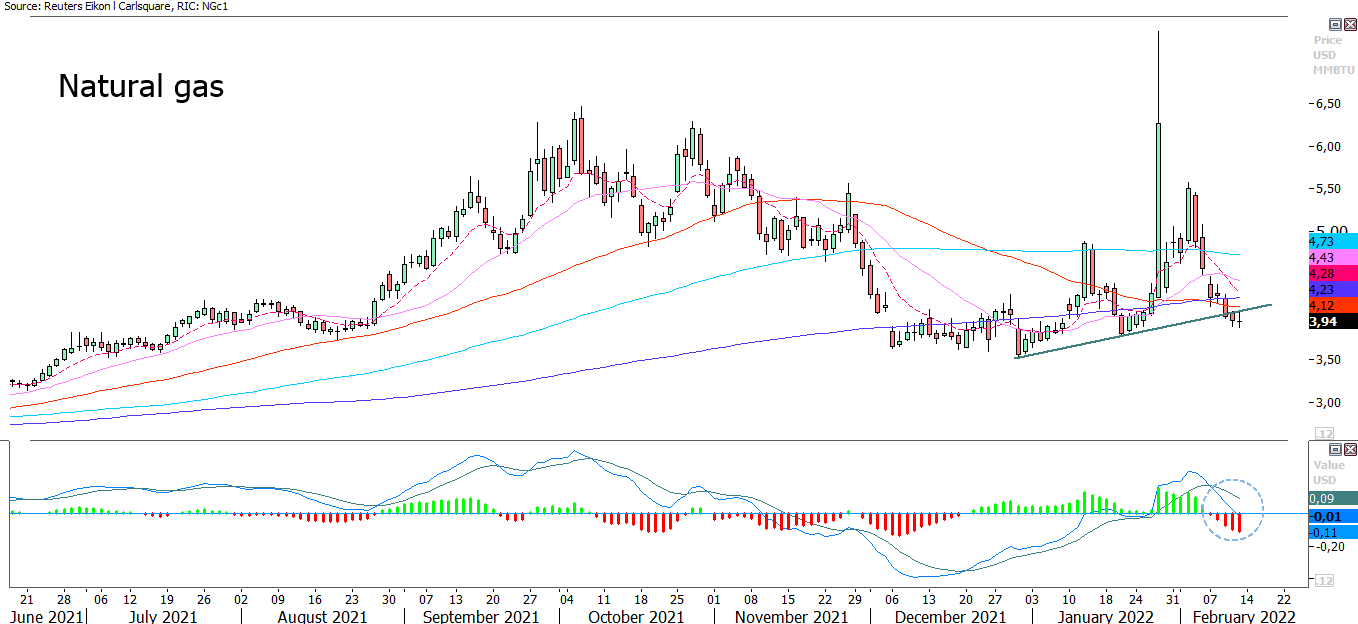
The weekly chart shows how natural gas is trading on a rising MA50:
Natural gas, weekly five-year price graph
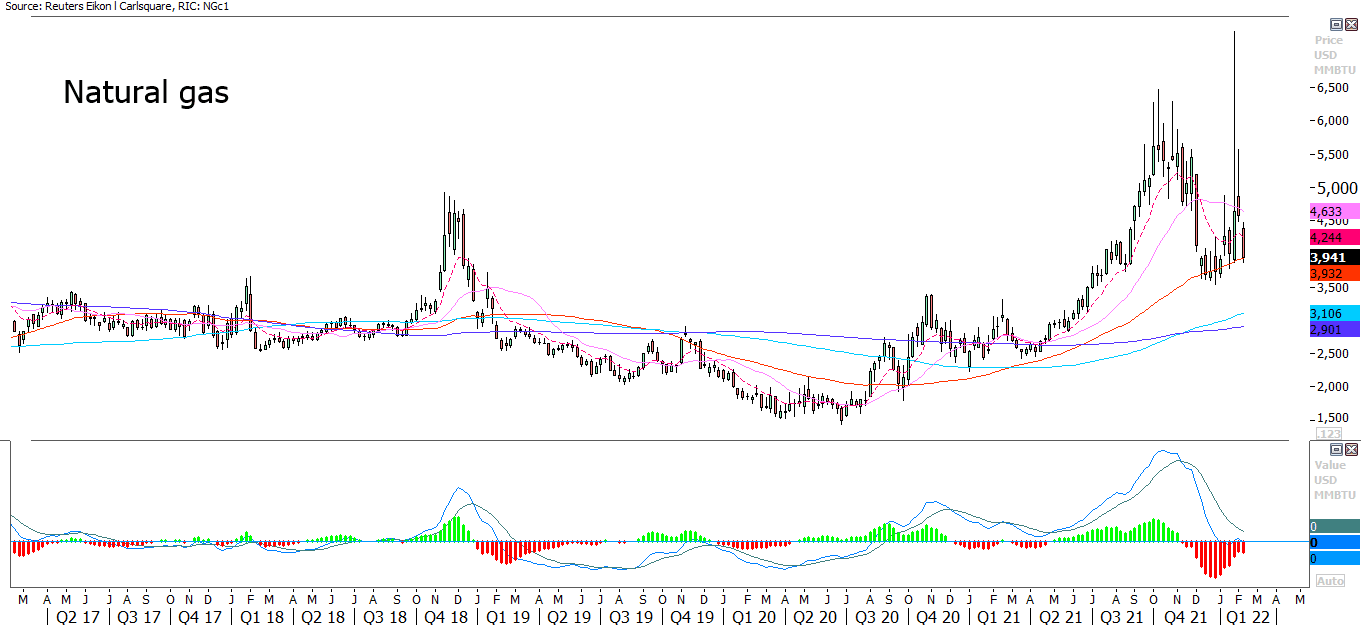
Will the travel and leisure sector outperform?
The sectors most affected by the Covid shutdown, the travel and event industries, have been negatively affected by the latest wave of Omicron and the following restrictions. However, regulations are withdrawn, and we will likely see the second race where people book their long-awaited holiday trips abroad. Is this an opportunity for Stoxx Europe 600 Travel & Leisure to catch up to Stoxx Europe 600:
Stoxx Europe 600 Travel & Leisure and Stoxx Europe 600, three-year chart

An excellent example that the recovery in events has now begun is Walt Disney. The division for parks, experiences, and products doubled its revenues on a year-to-year comparison. Despite the sharp upward rebound in recent days, Walt Disney shares still have a long way to go to their old highs.
Walt Disney share price graph: June 17, 2021, to February 11, 2022
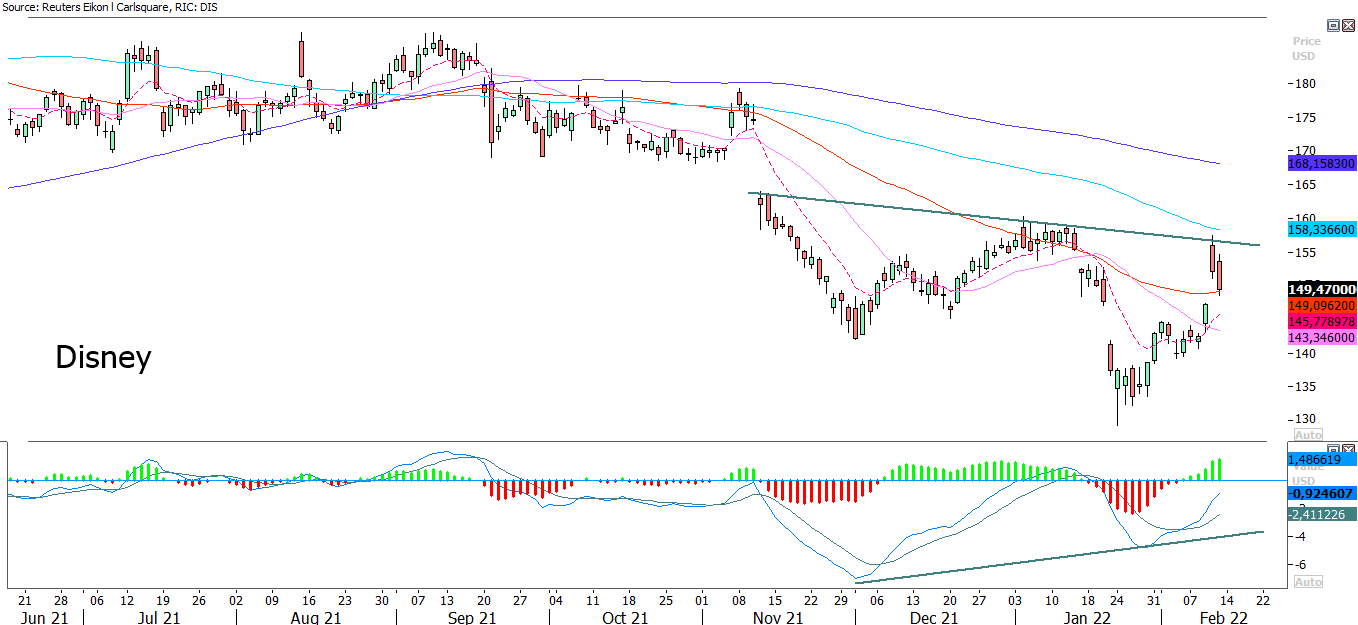
The Q4 2021 reporting season
Seventy-two percent of S&P 500 companies have reported their Q4 2021 earnings or the equivalent. Seventy-eight percent of report outcomes are better than analysts' forecasts, while 76% are better than analysts' forecasts at the revenue level. The best sector is the technology with 85 percent, followed by engineering with 84 percent in terms of earnings outturn. The worst report outcome is Utilities, with only 56 percent of results better than anticipated.
The engineering sector had the best earnings growth (91%) of the S&P500 sector, as shown in the graph below. Commodities are second with 60 percent and Consumer Discretionary third with 48 percent earnings growth. The best revenue growth is found in the energy sector with 88 percent, followed by Materials with 27 percent. Not unexpected, given the price hikes in recent months in those sectors.
Earnings Growth for the S&P500 companies in Q4 2021 by sector
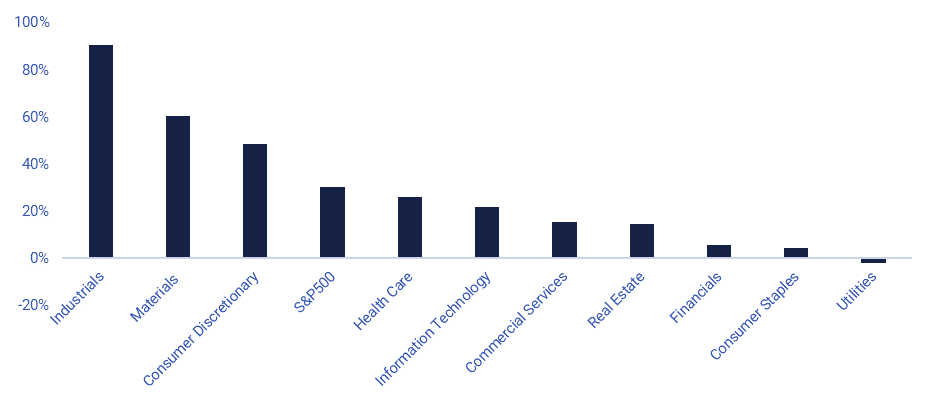
Meta share is looking for its bottom
Few have missed the significant setback for Meta Platforms (Facebook) in the number of active users. The positive from a fundamental perspective was that Meta Platforms managed to grow its revenues and produce profits above expectations. Meta Platforms should face greater demand in short to medium term with Covid restrictions gone. So has the share reached its bottom for now?
Meta platforms share price graph: June 10, 2021, to February 4, 2022
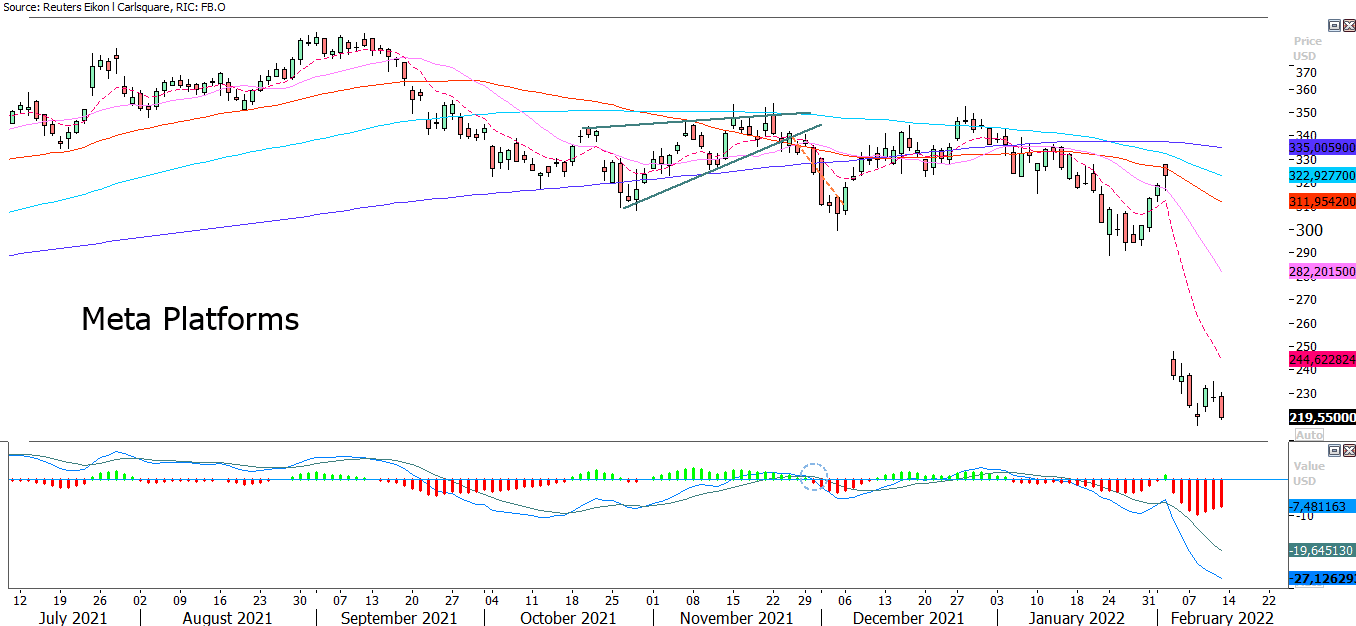
In the weekly chart below, one can see how the share is trading close to support around USD 210-215:
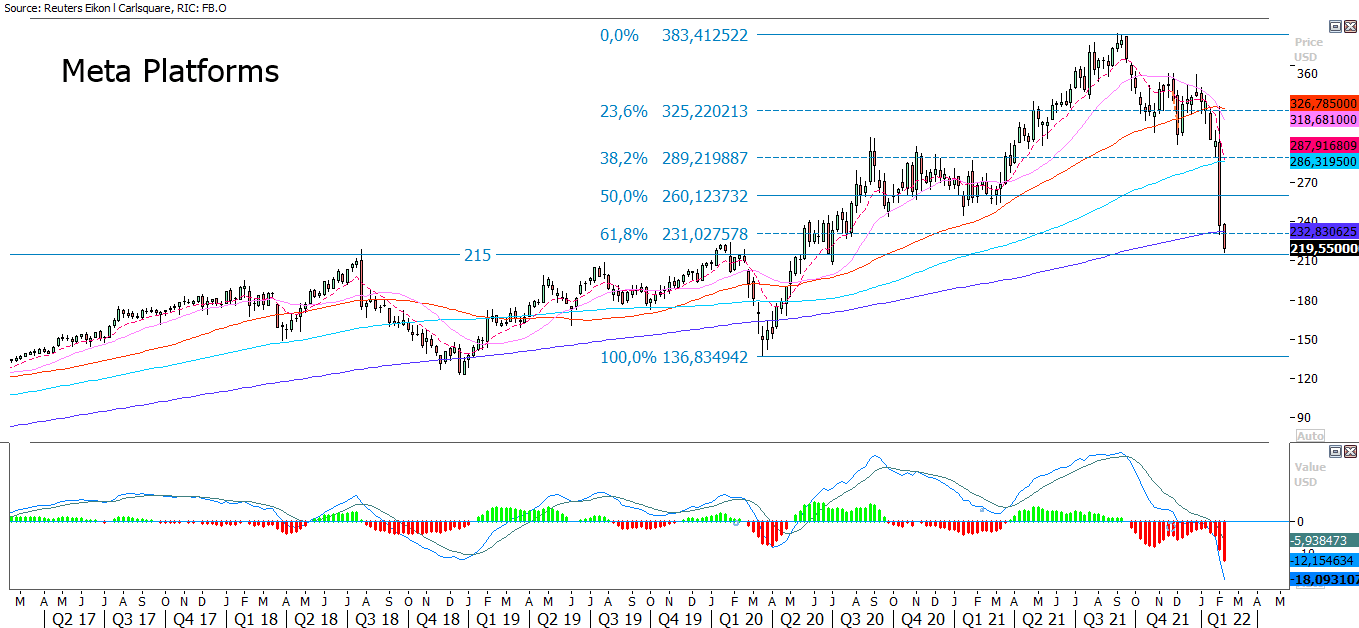
Meta Platforms, weekly five-year share price graph
Source: Refinitiv Eikon and Carlsquare. Note: Past performance is not a reliable indicator of future results.
The full name for abbreviations used in the previous text:
EMA 9: 9-day exponential moving average
Fibonacci: There are several Fibonacci lines used in technical analysis. Fibonacci numbers are a sequence of numbers in which each successive number is the sum of the two previous numbers.
MA20: 20-day moving average
MA50: 50-day moving average
MA100: 100-day moving average
MA200: 200-day moving average
MACD: Moving average convergence divergence
Risker
Important notice:
This information is neither an investment advice nor an investment or investment strategy recommendation, but advertisement. The complete information on the trading products (securities) mentioned herein, in particular the structure and risks associated with an investment, are described in the base prospectus, together with any supplements, as well as the final terms. The base prospectus and final terms constitute the solely binding sales documents for the securities and are available under the product links. It is recommended that potential investors read these documents before making any investment decision. The documents and the key information document are published on the website of the issuer, Vontobel Financial Products GmbH, Bockenheimer Landstrasse 24, 60323 Frankfurt am Main, Germany, on prospectus.vontobel.com and are available from the issuer free of charge. The approval of the prospectus should not be understood as an endorsement of the securities. The securities are products that are not simple and may be difficult to understand. This information includes or relates to figures of past performance. Past performance is not a reliable indicator of future performance.
